I have reviewed the comic book series called "The EC Archives".
From the 1950s Science Fiction Podcast.
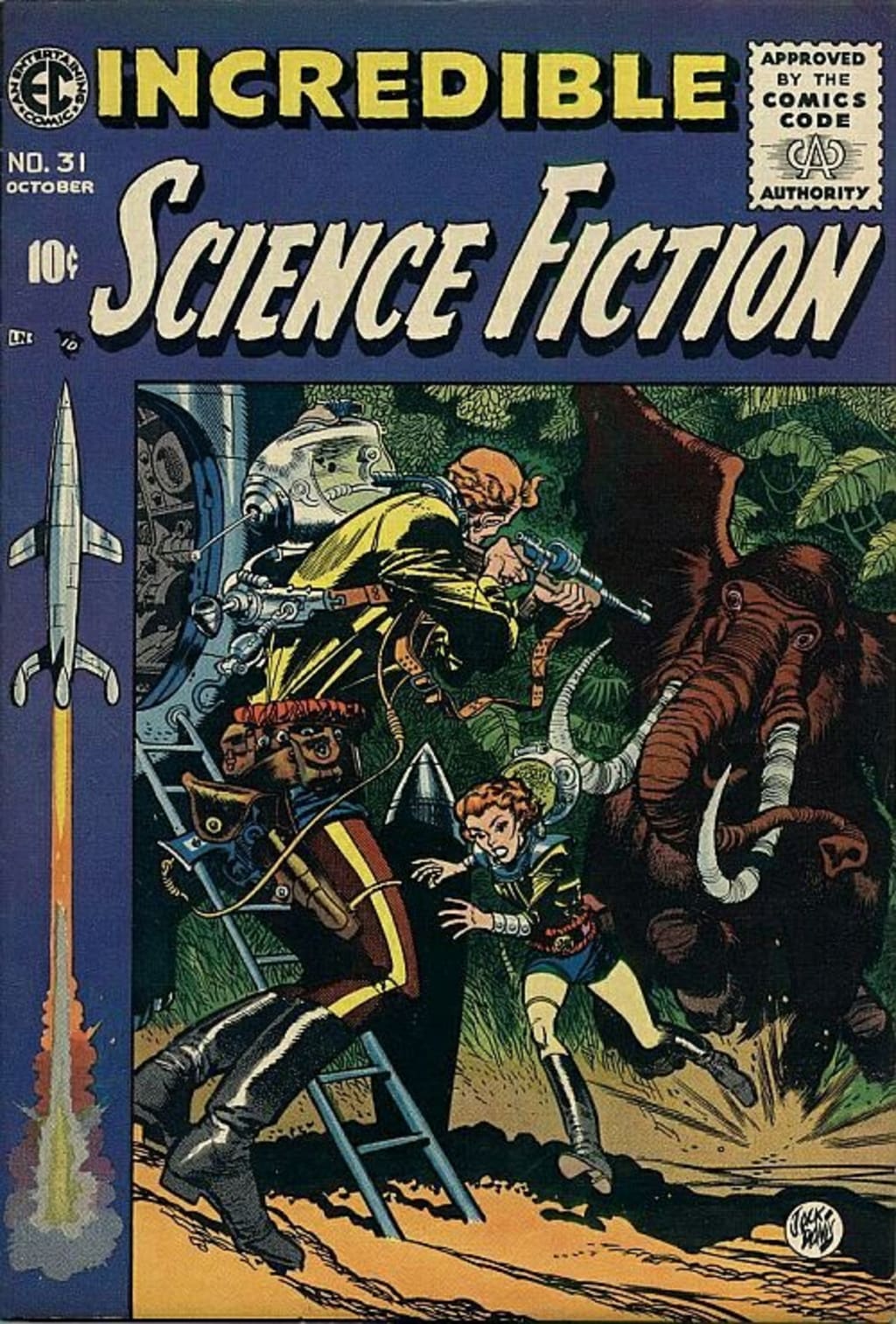
Welcome back to the 1950s Science Fiction Podcast. In this episode, I'll be discussing three comics from the EC Archives. These stories were originally published in Incredible Science Fictions issues #31 and #33, by EC Publishing. The first story, Fulfillment, was printed in #31; the second, Has Been, was also published in #31; and the last story, Kaleidoscope, was published in #33.

In a previous podcast, I discussed EC comics. You can refer back to Season One Episode 3, where I provided the background of EC comics and talked about some of their stories. Additionally, I did a show on a lesser-known comic from the 50s called Keyton of the Star Patrol, which is similar to Flash Gordon with the protagonist policing the universe. In this podcast, I will be talking about three stories from the EC archives Incredible Science Fiction, which was printed by Dark Horse Comics in 2017. The three stories range from comical to serious and thought-provoking.
Fulfillment.

The first story is titled "Fulfillment". It was written by Jack Oleck and illustrated by Berny Kringstien. The story was published in Incredible Science Fiction issue number 31 in 1955. I found it to be quite amusing, yet still a well-crafted story.
The story begins with ancient Egyptians worshiping in a temple. The head priest discusses how the great god Ra once walked the Earth. The scene then shifts to a comic panel depicting a 1950s-style rocket ship landing on an unknown planet. The ship's two occupants, a married couple on vacation, unfortunately experience a breakdown. It turns out they are lost on a planet that is off-limits to beings like them.
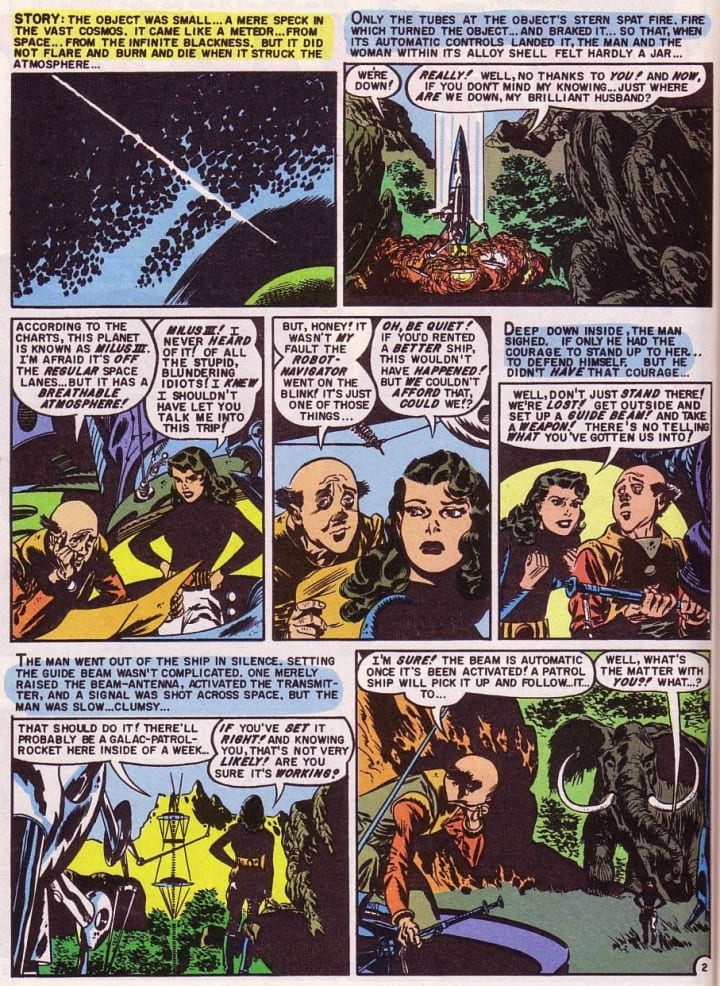
The husband steps outside the ship and sees a planet covered with lush jungles and animal life. He erects a radio beacon and asks for help from the Galactic Patrol, hoping they will rescue them within a week. However, days pass by, and no one comes to their rescue. The man's domineering wife insists on clearing out the jungle around the ship with a specific weapon, thinking that the ship was missed because it was hidden in the foliage.
The husband was hesitant but eventually used the weapon known as the Minn tubes, which had a devastating impact. It destroyed everything within thousands of square miles, wiping out jungles and animals alike. The area resembled the aftermath of an atomic bomb detonation. This weapon was intended to be used only in dire emergencies, and the wife convinced her husband that this was one such situation.
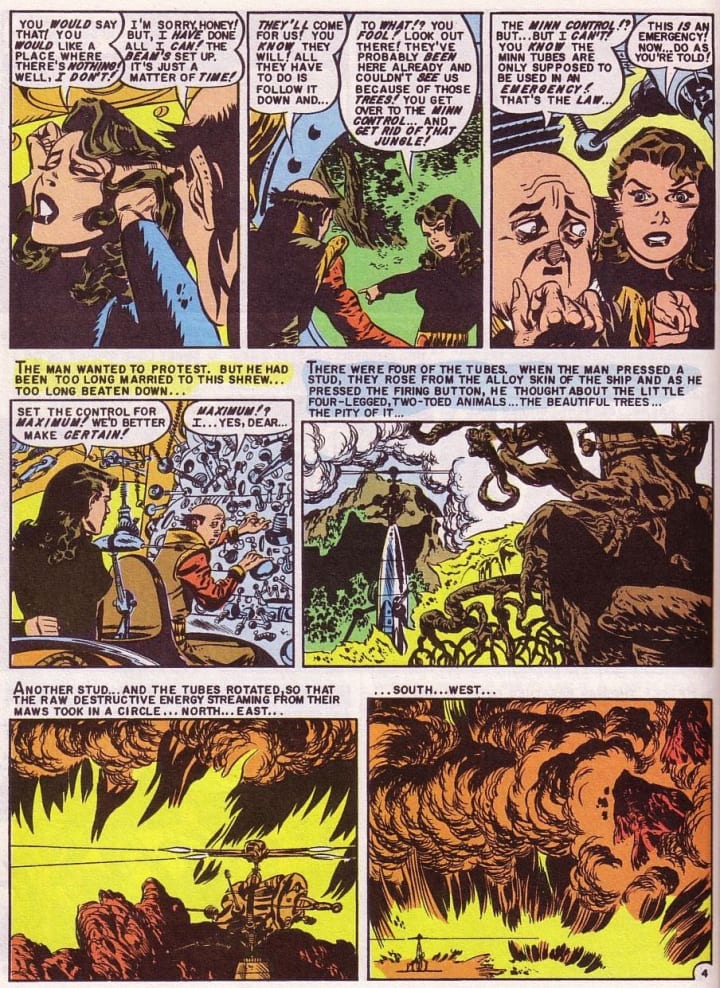
A galactic patrolman finally finds the ship and comes to the couple's aid. As soon as he arrives, he observes the desolation of the planet and concludes that the Minn Tubes were used. The patrolman rebukes the couple for using the weapon and emphasizes that they should not have been on that planet in the first place due to their protected status. He informs them that he must report the use of the weapon, and they may face a fine for having used it. Meanwhile, the wife protests the patrolman's words by explaining that it was an emergency and they had no choice but to use it. However, the patrolman reiterates that they may still be fined for the use of the Minn tubes.
After repairing the ship, the patrolman discovered that it was a simple fix, and was able to get the couple on their way quickly. As they prepared to launch, the husband took one last look at the planet, dreaming of escaping his domineering wife and becoming a god. They wore new oxygen masks that were designed for more efficient use as they took off. A primitive human, hiding behind a rock, observed the blast-off. The couple's masks resembled bulls or steers, with large snouts and ears.
In the final comic panels, the high priest stood against a stone bust of the bull-like mask worn by the couple. He proclaimed, "Behold the image of RA!"

I found the story quite enjoyable and intriguing. It revolved around the ancient astronaut theory, which was not very popular until the 60s but gained traction in the 50s with the surge of UFO sightings. People claimed to have had contact with extraterrestrial beings cand traveled to other planets with them, which was dubbed the contactee movement.

It was fascinating that the rocketship was fixed with just a simple repair. I suppose the husband knew how to fix it, but didn't want to so that he could stay there for longer. Finally, I found it amusing that the police treated their violation of the law as if it were a parking ticket.
Kaleidoscope

In issue #33 of the publication, there was a story called Kaleidoscope. The story is a serious one and starts with a comic panel of a man observing a view screen on a rocket ship. The following panels show a battle between spaceships from Earth and Venus. The story was written by Jack Oleck and illustrated by Jack Davis.
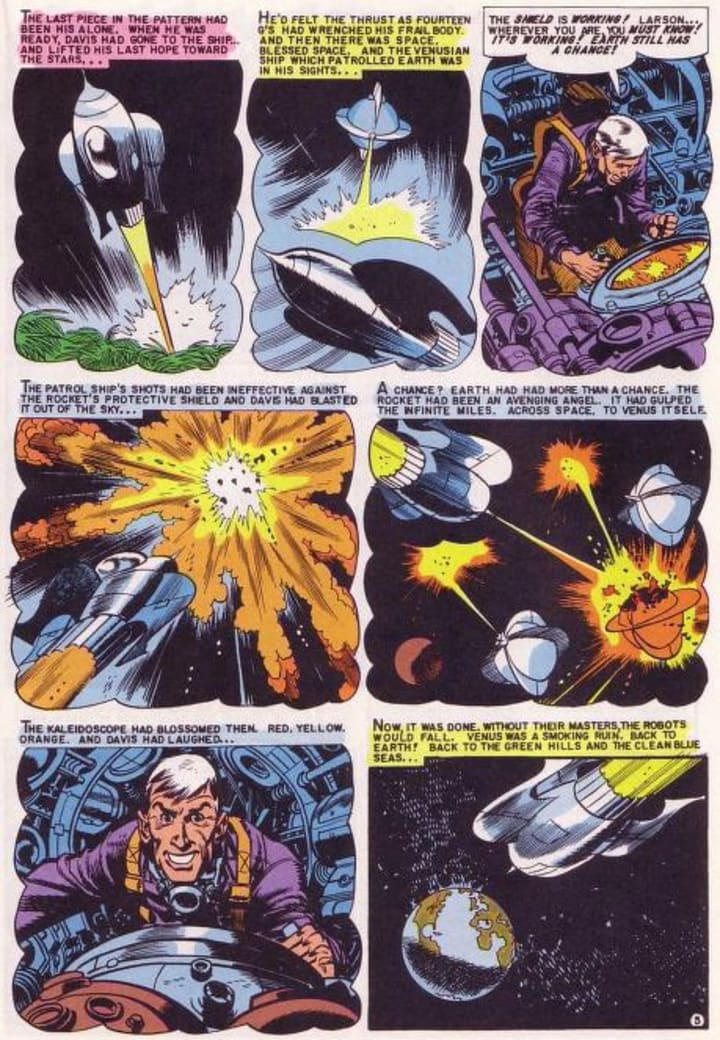
The comic panels depict how the Planet Venus conquered Earth using their superior power. While the protagonist, Davis, desires to actively resist the robot occupation force that subjugated humans, he is warned to be careful as he is among the few rocketship pilots remaining. Later, the panels display scenes of Davis fighting and defeating the Venusian fleet, seeking revenge for the damage they inflicted upon Earth and its people.
As he reminisces, he recalls finding an intact rocketship in the nearby forest. Davis informs the members of the resistance forces about his discovery, and they start repairing it. Different resistance fighters work together to make the rocketship flyable again, but the effort results in one death.
At this point, it seems that Davis has successfully destroyed the entire enemy fleet on his own. He then lands the rocketship back on the ground, where he encounters an old man. To his surprise, Davis realizes that he has aged by at least 30 years since the Venuesn invasion of Earth. Suddenly, he hears a woman's voice calling out to him, and it turns out to be his wife. She urges him to stop messing around with the old rocketship before the robot guards catch him. In the final panel, the couple is shown walking back to their encampment.
Davis had been imagining what it would have been like if the ship could have taken off, but in reality, it would have been one ship against a large fleet. He has now become so broken that he can only reminisce about what could have been.
It was a poignant tale highlighting the possibility of a similar fate befalling any nation. The fear of a foreign invasion was a constant presence in the minds of Americans during the 1950s, especially during the early days of the Cold War when the Soviet Union was seen as a potential threat. Moreover, the memories of the recent World War remained fresh in everyone's thoughts.
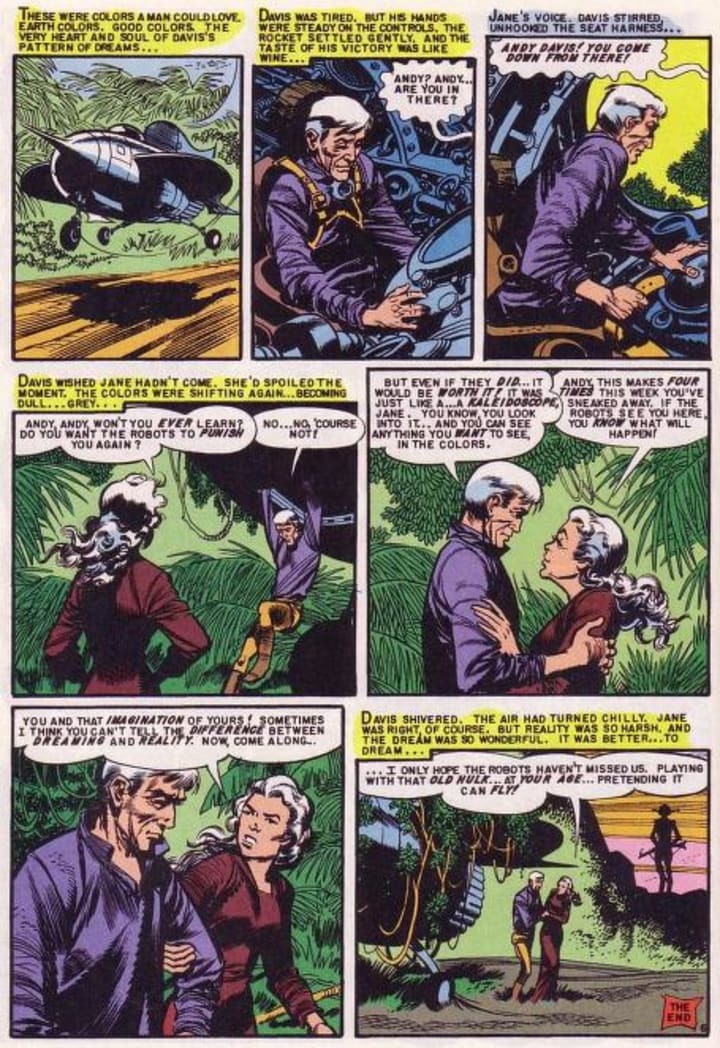
Has Been

In this discussion, I will be highlighting a comic story titled "Has Been," which appeared in issue #31 of the comic book. The story was written by Jack Oleck and illustrated by Wally Wood. It is a thought-provoking story that deals with a father's son who has a dream of exploring space and must now defend the Earth from invaders. The story is quite captivating and leaves one with much to think about.
The opening comic panels depict a battle in progress, being observed by a military officer dressed in a futuristic space suit, complete with a helmet and goggles. The goggles are reminiscent of the night vision devices used by soldiers today. The officer reflects on his current role as a commander of military forces and expresses his desire to retire soon, as he has grown weary of leading troops into battle.

As the captain of the ship directs the fleet against the enemy ships, memories of his childhood conversations with his father flood his mind. He tells his son that space is a realm for the young and not so much for the older generation like himself. The boy's father is a rocketship designer and the son is fascinated by his father's creations. The son expresses his desire to fly one of his father's rockets one day and explore the vast expanse of space.
In the comic panel, the story is told in flashback mode, where beings from another world have gone to war with Earth and are threatening the planet with an ultimatum. The father, being too old to help in the war effort, is advised by his friend that it is up to the young to fight and protect the planet. Later, the man's son is inducted into the military and qualifies for the rocket pilot program.

After the Captain graduated from pilot training, he was appointed to lead the fleet of warships defending Earth. The first battle was lost, but the Captain's leadership improved and the fleet was able to repel the invasion force in the second battle. They even inflicted damage on the enemy's homeworld. After claiming victory, the Captain ordered the fleet to return home. During the journey, he reflected on how space had become his home, but not in the way he had hoped. The constant battles had left him battle-weary and he longed to retire, but he knew he could not.
When the fleet arrives at Earth, the crew performs a pass-and-review ceremony to bid farewell to the Captain. After that, the Captain heads back home to visit his parents. Interestingly, his father is the same man who designed the rocket. In the final comic panels, the Captain is shown gazing at the stars while his father approaches him. The father notices that his son is in tears and tries to console him. It is then revealed that the Captain is not an adult, but a 15-year-old boy. The father acknowledges his son's emotions and says that growing up is inevitable.

The story I came across was thought-provoking. It described a society that required the sacrifice of its youth for the survival of the country. I couldn't help but think that the writer had the conscription of youth during World War II in mind when he wrote this story. It has only been a decade since Germany and Japan were forced to conscript youth for the defense of their respective countries during the war. This story demonstrates how relying on the youth of the country to protect itself will have far-reaching effects. Teenagers would be forced to mature early in life without the usual right of passage afforded to them during peacetime. They would miss out on high school proms, the freedom to choose where they want to attend college, and have little time to engage in relationships with the opposite gender. Even marriage and family may be postponed. Similar themes are also present in popular science fiction novels like Ender's Game and The Hunger Games.
That concludes today's podcast. I hope you found it both entertaining and informative. Stay tuned for the next episode, which will be released as soon as possible. In the meantime, you can follow me on "X" @EdwardGerman3 on Instagram as Sutterbug 1681. You can also visit my WordPress blog at the1950ssciencefictionpodcast.blog, where you can leave comments and feedback. Thank you for listening, and I look forward to your continued support.

About the Creator
Edward German
A long-time sci-fi fan who loves the internet. I am also writing on subjects other than sci-fi.
you can follow me on "X" @EdwardGerman3 Listen to my podcast The 1950s Science Fiction Podcast on Spotify for Podcasters.






Comments
There are no comments for this story
Be the first to respond and start the conversation.